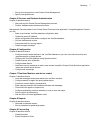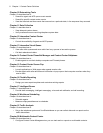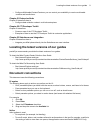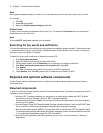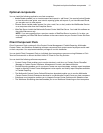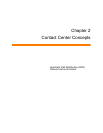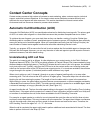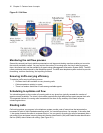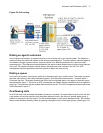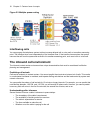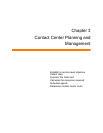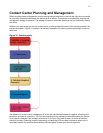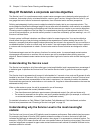Automatic Call Distribution (ACD) 15
Contact Center Concepts
Contact centers process a high volume of contacts to meet marketing, sales, customer service, technical
support, and other business objectives. A fine-tuned contact center distributes contacts efficiently and
optimizes the use of agents and other resources. This section describes the inbound contact center
environment and how resources interact to process voice contacts.
Automatic Call Distribution (ACD)
Automatic Call Distribution (ACD) is a specialized mechanism for distributing incoming calls. The primary goal
of ACD is to ration calls to agents in a cost-effective manner that provides acceptable service to callers.
To optimize the use of agents, you cross-train them so they can handle a variety of inquiries. Rather than
distributing calls to a number of small, specialized agent or extension groups, ACD distributes them efficiently
among the entire pool of available agents. When you consolidate resources (use the Pooling Principle), the
same number of contact center agents handle more calls while maintaining Service Levels.
Typically, you program ACD to ensure the first call to arrive reaches the first available agent or the agent who
has been idle the longest. However, you can vary the order of calls and agents to provide superior service to
preferred customers, and skills-based routing.
Understanding ACD call flow
The path of an incoming call is as follows. A caller telephones your contact center via the Public Switched
Telephone Network (PSTN). (The PSTN is a global collection of Central Offices (COs) interconnected by long-
distance telephone switching systems.) The local CO directs the call to one of your trunk groups. An available
trunk picks up the call. Typically, calls from the PSTN arrive to the contact center over incoming trunks and
calls from the contact center to the PSTN travel over outgoing trunks. If no trunks are available, the call does
not get through to the system (it is blocked) and the caller receives a busy signal.
When a trunk picks up a call, it forwards it through to a group of agents handling calls, or to some other
answering point. The call arrives at the ACD queue of an agent group. The queue delays the call rather than
blocking the call from entering the system. The length of time the caller waits in queue is the queue time.
While waiting in queue, the caller listens to product features, announcements, or other messages provided by
a Recorded Announcement Device (RAD). The caller can wait patiently in queue for an available agent, leave
a voice mail message, or hang up (abandon) the call. (See Figure 2-1.)
An agent handles the call. The time the caller spends talking to the agent is the ACD Handling Time (including
the hold time). If the agent calls the supervisor in search of more information (while the caller is on hold) and/
or transfers or conferences the call, these times are added to the ACD Handling Time value.
For example, an agent speaks to a caller for two minutes and then puts the caller on hold for three minutes
and tries to solve the problem. This may include a call to the supervisor. The agent then initiates a conference
call with the caller and a third party and they speak for three minutes and resolve the issue. Therefore, the
ACD Handling Time for the agent is 2 + 3 + 3 = 8 minutes.
When the call is completed, the agent might need to perform additional work associated with the call. The time
taken to perform this work is the Wrap Up Time.



